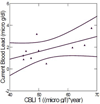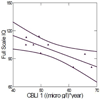Blood lead levels and cumulative blood lead index (CBLI) as predictors of late neurodevelopment in lead poisoned children
- PMID: 21827276
- PMCID: PMC3229913
- DOI: 10.3109/1354750X.2011.604133
Blood lead levels and cumulative blood lead index (CBLI) as predictors of late neurodevelopment in lead poisoned children
Abstract
Objective: To find the best lead exposure assessment marker for children.
Methods: We recruited 11 children, calculated a cumulative blood lead index (CBLI) for the children, measured their concurrent BLL, assessed their development, and measured their bone lead level.
Results: Nine of 11 children had clinically significant neurodevelopment problems. CBLI and current blood lead level, but not the peak lead level, were significantly or marginally negatively associated with the full-scale IQ score.
Conclusion: Lead exposure at younger age significantly impacts a child's later neurodevelopment. CBLI may be a better predictor of neurodevelopment than are current or peak blood lead levels.
Figures


Similar articles
-
Longitudinal associations between blood lead concentrations lower than 10 microg/dL and neurobehavioral development in environmentally exposed children in Mexico City.Pediatrics. 2006 Aug;118(2):e323-30. doi: 10.1542/peds.2005-3123. Pediatrics. 2006. PMID: 16882776
-
[Prenatal lead exposure related to cord blood brain derived neurotrophic factor (BDNF) levels and impaired neonatal neurobehavioral development].Zhonghua Yu Fang Yi Xue Za Zhi. 2016 Jun;50(6):514-8. doi: 10.3760/cma.j.issn.0253-9624.2016.06.008. Zhonghua Yu Fang Yi Xue Za Zhi. 2016. PMID: 27256731 Clinical Trial. Chinese.
-
Cognitive development and low-level lead exposure in poly-drug exposed children.Neurotoxicol Teratol. 2009 Jul-Aug;31(4):225-31. doi: 10.1016/j.ntt.2009.03.002. Epub 2009 Apr 2. Neurotoxicol Teratol. 2009. PMID: 19345261 Free PMC article.
-
A blood lead benchmark for assessing risks from childhood lead exposure.J Environ Sci Health A Tox Hazard Subst Environ Eng. 2009 Oct;44(12):1200-8. doi: 10.1080/10934520903139829. J Environ Sci Health A Tox Hazard Subst Environ Eng. 2009. PMID: 19847706 Review.
-
Very low lead exposures and children's neurodevelopment.Curr Opin Pediatr. 2008 Apr;20(2):172-7. doi: 10.1097/MOP.0b013e3282f4f97b. Curr Opin Pediatr. 2008. PMID: 18332714 Review.
Cited by
-
Determining prenatal, early childhood and cumulative long-term lead exposure using micro-spatial deciduous dentine levels.PLoS One. 2014 May 19;9(5):e97805. doi: 10.1371/journal.pone.0097805. eCollection 2014. PLoS One. 2014. PMID: 24841926 Free PMC article.
-
XRF-measured bone lead (Pb) as a biomarker for Pb exposure and toxicity among children diagnosed with Pb poisoning.Biomarkers. 2016;21(4):347-52. doi: 10.3109/1354750X.2016.1139183. Epub 2016 Feb 9. Biomarkers. 2016. PMID: 26856822 Free PMC article.
-
Multi-media biomarkers: Integrating information to improve lead exposure assessment.Environ Res. 2020 Apr;183:109148. doi: 10.1016/j.envres.2020.109148. Epub 2020 Jan 20. Environ Res. 2020. PMID: 32004829 Free PMC article.
-
Early childhood lead exposure is not reflected in adult bone lead: Results of a sub-cohort of African American women in the Cincinnati lead study.Environ Res. 2023 Aug 15;231(Pt 1):115956. doi: 10.1016/j.envres.2023.115956. Epub 2023 Apr 25. Environ Res. 2023. PMID: 37105282 Free PMC article.
-
Forced swimming stress increases natatory activity of lead-exposed mice.Toxicol Res. 2020 Jun 5;37(1):115-124. doi: 10.1007/s43188-020-00045-2. eCollection 2021 Jan. Toxicol Res. 2020. PMID: 33489862 Free PMC article.
References
-
- Brito JA, McNeill FE, Webber CE, Wells S, Richard N, Carvalho ML, Chettle DR. Evaluation of a novel structural model to describe the endogenous release of lead from bone. j Environ Monit. 2002;4:194–201. - PubMed
-
- Farias P, Echavarria M, Hernandez-Avila M, Villanueva C, Amarasiriwardena C, Hernandez L, Aro A, Hu H. Bone, blood and semen lead in men with environmental and moderate occupational exposure. Int j Environ Health Res. 2005;15:21–31. - PubMed
-
- Goldman RH, White R, Kales SN, Hu H. Lead poisoning from mobilization of bone stores during thyrotoxicosis. Am j Ind Med. 1994;25:417–424. - PubMed
Publication types
MeSH terms
Substances
Grants and funding
LinkOut - more resources
Full Text Sources
Medical
